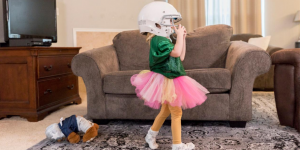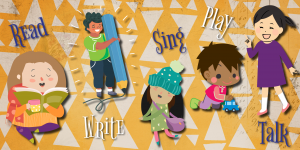
Parents and caregivers are a child's first teacher and playmate. Playing together creates bonding time, memorable experiences, and helps children develop problem-solving and social skills.
While a child will have their favorite toy or activity, both children and parents can have fun experimenting with various activities that will provide newfound ways to explore the world around them. While playing, ask children open-ended questions to promote creative thinking and build vocabulary.
Try these activities at home using everyday household items!
Babies
-
Balls
- Sit across from your baby and roll a ball back and forth to each other. If you have various balls, you can discuss colors, patterns, and textures.
- Say: “This ball feels smooth!” or “This ball is shiny!”
-
Blocks
- Create blocks from different shape boxes or containers. Grab a few different shapes (cereal boxes, formula container) and tape the edges together to seal the item. Baby can then stack one on top of the other!
- Say: “What color is this block (container)…it’s red!” or “Does this container balance on this block?”
-
Getting Dressed
- Dressing baby can turn into a fun game by interacting with baby and naming body parts. Ex. Count arms while putting them through sleeves and count baby's toes while putting on socks.
- Say: “Here is one arm! Where’s baby’s other arm?...here it is!” or “How many toes does baby have?”
 Toddlers
Toddlers
-
Bowling
- Empty 2 liter bottles and grab a small or medium size ball.
- Line bottles up as pins and get ready to bowl!
- Say: “Let’s count how many pins we knocked down…1, 2, 3…!"
-
Digging Station
- Pour Cheerios (or similar cereal like Chex) into a container with some “hidden treasures,” such as marshmallows or dried fruit.
- Using little measuring cups or scoopers, children can dig and search for the “treasures,” and even enjoy a little snack.
- Say: “What kind of hidden treasures do you think you’ll find?” or “How many hidden treasures are in the container?"
-
Sponges
- Cut sponges into different shapes and sizes. Place the sponges in a tray with water. Children will strengthen fine motor skills (squeezing water out of sponges) and feel different textures.
- Say: “What does the sponge feel like…squishy, smooth, wet, dry?” or “What happens when you squeeze the sponge?”
Preschoolers
-
Puppets
- Make puppets using brown sandwich bags. With the bottom flap facing up, start drawing – puppets can be super simple or extremely detailed. The point is to have fun!
- After puppets are finished, ask your child if they would like to have a puppet show and have their puppet come to life!
- Say: “Tell me about your puppet!” or “What does your puppet like to do?”
-
Dress up
- Find a few pieces of clothing, extra fabric, or accessories that are no longer used (ex. scarves, pants, dresses, hats, jewelry, jackets, shoes) and create a “dress up” bin.
- Let kids comb through the bin and make their own unique costume using their creativity and imagination.
- Say: “How many ways can you wear (or style) the jacket?” or “Tell me about your costume.”
-
Puzzles
- Make puzzles from cereal boxes by cutting the side of the box into miscellaneous shapes/pieces.
- While the puzzle is together, show your child and talk about the picture on the puzzle. Then mix the pieces up and try to put them back together again.
- Say: “Can we flip the pieces around and see how they fit together?” or “Do you remember what was on the top of the picture (puzzle) or what was on the bottom?”
-Monique, Children's Librarian, Mission Library
 Read, Write, Talk, Sing, Play!
Read, Write, Talk, Sing, Play!
Play comes so naturally to children and is an essential element to lifelong success. When children play, they are practicing and perfecting early literacy and life skills!
Read more about early literacy and how you can make a difference in your child's life.

